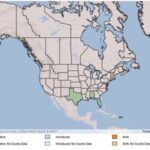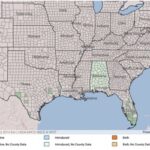Eleocharis interstincta
Illustration: USDA-NRCS PLANTS Database / Britton, N.L., and A. Brown. 1913. An illustrated flora of the northern United States, Canada and the British Possessions. 3 vols. Charles Scribner’s Sons, New York. Vol. 1: 311.
What is Knotted Spikerush?
Physical Characteristics
Flowers:
- 50-140 flowers per spikelet
- 0.14-0.2 inches long & wide
- Rounded
- 6 short, stiff hairs; brownish in color
- Cylindrical
- 0.86-1.7 inches long
- 0.2-0.28 inches thick
Fruit:
- One seeded
- Does not open to release seed when ripe
- Bulging on both sides
- 0.08-0.09 inches long
- Brown in color when not ripe (yellow until ripe)
Stem:
- Hollow stems
- 1.75-3.75 inches long
- 0.16-0.36 inches thick
- Straight
- Smaller at top than at base
- Sheaths dark red in color
Where Does it Grow?
USDA, NRCS. The PLANTS Database (http://plants.usda.gov). National Plant Data Team, Greensboro, NC 27401-4901 USA.
Knotted spikerush can be found in mud and along the edges of streams, lakes and ponds.
Pros and Cons of Knotted Spikerush
Docks, geese, muskrats, and nutria all eat portions of spike rushes, from seeds, to rhizomes and tubers. Submerged portions of all aquatic plants provide habitats for many micro and macro invertebrates. These invertebrates in turn are used as food by fish and other wildlife species (e.g. amphibians, reptiles, ducks, etc.). After aquatic plants die, their decomposition by bacteria and fungi provides food (called “detritus”) for many aquatic invertebrates.


